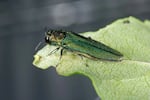For years, Portland area politicians have grappled with protecting the city’s hottest neighborhoods by planting more trees, especially in low-income areas with sparse tree canopy.
Foresters say tree pests are the biggest threat to that progress, weakening the region’s ability to mitigate deadly temperatures similar to this month’s heat wave.
Tree shade is crucial to helping urban neighborhoods stay cool. A spot under a tree can be up to 45 degrees cooler than one exposed to the sun. Collectively, shade trees lower overall temperatures by adding moisture to the air. Two beetle species could threaten the ash and oak trees in that canopy if they take hold in the city.
Like many cities, tree canopy cover isn’t spread equally through Portland. Neighborhoods with the lowest incomes have the fewest trees and are subsequently the hottest.
Oregon Department of Forestry urban forester Lilah Gonen worries that losing ash and oak trees to pests will set the region back in meeting its tree canopy goals — and addressing the inequities of neighborhood temperatures.
“This is not just an ecological issue,” Gonen said. “This is a human health issue. This is an equity issue. This is a social issue. And it’s going to require the input of people from all different industries to alleviate the effects.”
One of the pests that could threaten Portland trees is the emerald ash borer, a rice-sized iridescent beetle. It has killed tens of millions of ash trees across the Midwest and East Coast over the last two decades, decimating life-saving tree shade in major cities like Chicago and Minneapolis.

This photo shows the side view of an adult emerald ash borer. The invasive beetle is native to Asia and has killed more than 100 million ash trees in the U.S. since its arrival in 2002. It was first detected in Oregon in Forest Grove in June 2022.
James E. Zablotny/USDA APHIS
Oregon foresters found the emerald ash borer in Forest Grove in 2022, the first time it was found on the West Coast. Officials have managed to keep it contained to Washington County through wood and tree quarantines, but some experts say it’s only a matter of time before it spreads through the Willamette Valley.
“We’re working to contain the known infestation as best we can to slow it down,” Gonen said. “We’re not deluding ourselves into thinking that we can stop this.”
The state has one native ash species, called Oregon ash, shading urban and wild areas across the valley. But several other ash varieties are planted in cities and towns across the state. Before the 2000s, they had been the go-to residential landscaping tree, prized for their hardiness, drought tolerance and large canopy.
About 5% of Portland’s residential trees are ash varieties. Gonen said the city is luckier than communities in the Midwest, where ash trees are more prolific. Still, Portland can’t afford to lose one in 20 trees to a pest, especially since it is already losing tree shade. Many Eastern and Central Oregon neighborhoods also rely on ash varieties for residential shade.
It’s not clear when the borer might infest the Willamette Valley, or how bad it could be. It could also take over other regions of the state.
Gonen said Willamette Valley residents with ash trees on their properties should consult with an arborist. One potential tool is an insecticide that’s been effective against the borer in other parts of the country. It needs to be injected every couple of years.
Gonen said the insecticide appears to have few side effects on the tree and has “extremely low” effects on surrounding wildlife, insects and other plants.
“It’s all contained within the tree,” Gonen said. “Its effects on pollinators are also virtually zero.”
Outside of urban areas, the ash borer could kill trees that shade streams and rivers, in turn making those waterways warmer. That’s bad news for the Willamette River, which is already struggling to meet federal regulations on temperature.
Warmer temperatures could kill native fish and spur algal blooms that poison drinking water and recreational rivers.
“The big picture is we have a lot of ash in western Oregon and it’s doing a lot of ecological work,” retired Oregon State University forestry professor Dave Shaw said. “Losing it is going to be really huge.”
A parasitic wasp could help foresters reign in the borer. The Oregon Department of Agriculture has released some of these wasps in the Forest Grove area and are monitoring their progress. These wasps are small, they only target the emerald ash borer and they don’t sting.
“It’s a Band-Aid solution until we come up with something better,” Shaw said.

The Mediterranean oak borer leaves small, round holes in the cut face of wood.
Photo courtesy Bob Rabaglia, U.S. Forest Service
Foresters are also worried about the Mediterranean oak borer, which tunnels beneath an oak tree’s bark, carrying with it a fungus that grows within the tree and becomes the borer’s main food source. The fungus can cause a disease called oak wilt, which blocks trees’ ability to take in water and nutrients. Infected trees typically die within a few years.
Shaw is studying the oak borer along with a grad student at OSU. The beetle was first introduced from Europe to California’s wine country. It first appeared in Troutdale in 2018.
“We’ve been seeing this in declining trees now and it’s got us really, really worried,” Shaw said. “This could severely affect Oregon white oak.”



